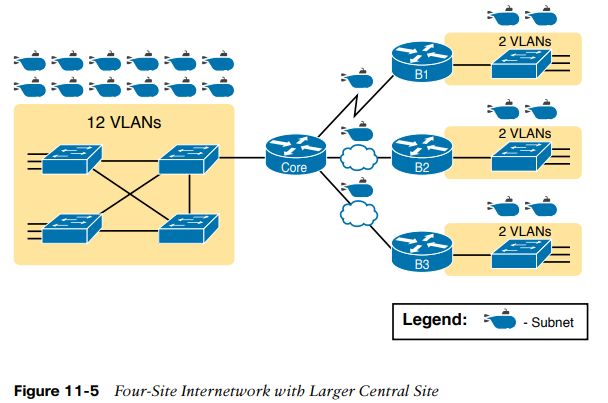IPv4 Subnetting
Analyze Subnetting and Addressing Needs
Which hosts should be grouped together into a subnet?
- Addresses in the same subnet are not separated by a router.
- Addresses in different subnets are separated by at least one router.
Note that the point-to-point WAN link in the figure also needs a subnet. Both R1 and R2 will have IP addresses on their WAN interfaces, and the addresses will be in the same subnet. Because the router's main job is to forward packet from one subnet to another, routers typically connect to multiple subnets. To do so, routers are configured with different IP addresses, one per interface. These addresses will be in different subnets because the interfaces connect the router to different subnets.
How many subnets does this internetwork require?
To count the locations that need a subnet, we require access to network diagrams, VLAN configuration details, and details about WAN links. We should plan for one subnet for every:
- VLAN
- Point-to-point serial link
- Ethernet WAN (Ethernet Line Service)
Consider the figure above. In this case, each branch has 2 VLANs, which along with the 3 WAN subnets and the 12 subnets on the central site (remember, one per VLAN), makes this internetwork require a total of 21 subnets. In a real job, you would consider the needs today as well as how much growth you expect in the internetwork over time. Any subnetting plan should include a reasonable estimate of the number of subnets you need to meet future needs.
How many host IP addresses does each subnet require?
Every device that connects to a subnet needs an IP address. For a totally new network, you can look at business plans—numbers of people at the site, devices on order, and so on—to get some idea of the possible devices. When expanding an existing network to add new sites, you can use existing sites as a point of comparison and then find out which sites will get bigger or smaller. And don’t forget to count the router interface IP address in each subnet and the switch IP address used to remotely manage the switch.
Will we use a single subnet size for simplicity, or not?
The final choice in the initial planning step is to decide whether you will use a simpler design by using a one-size-subnet-fits-all philosophy. A subnet’s size, or length, is simply the number of usable IP addresses in the subnet. A subnetting design can either use one size subnet or varied sizes of subnets, with pros and cons for each choice.



